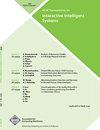结构化数据中发现子空间的共现可视化分析
IF 4.8
4区 计算机科学
Q2 COMPUTER SCIENCE, ARTIFICIAL INTELLIGENCE
引用次数: 1
摘要
我们提出了一种方法,显示所有相关的子空间的分类数据浓缩在一个单一的图片。我们将属性的分类值建模为与使用模式挖掘从结构化数据生成的数据分区共现。我们表明,这些共现是先验的,允许我们大大减少搜索空间,有效地生成压缩的图片,而传统的方法过滤掉了几个子空间,因为这些被认为是不重要的。识别感兴趣的子空间是一项常见的任务,但由于指数搜索空间和维度的诅咒,这一任务很困难。这种任务的一个应用程序可能是识别由诸如性别、年龄和糖尿病类型等属性定义的患者队列,这些属性具有共同的患者历史,并将其建模为事件序列。按这些属性过滤数据是很常见的,但很麻烦,而且通常不允许对子空间进行比较。我们提供了一种强大的多维模式探索方法(mdpe方法),该方法与结构化数据类型无关,该数据类型将多个属性及其特征建模为共现,允许用户识别和比较单个图片中感兴趣的数千个子空间。在我们的mdpe方法中,我们引入了两种方法来显著减少搜索空间,仅以两个表的形式输出搜索空间的边界。我们在交互式可视化界面(MDPE-vis)中实现mdpe方法,该界面提供了可扩展的、基于像素的可视化设计,允许对结构化数据中的子空间进行识别、比较和意义构建。我们使用黄金标准数据集和外部领域专家进行的案例研究证实了我们的方法和实现的适用性。第三个用例揭示了我们方法的可扩展性,一个有15个参与者的用户研究强调了它的有用性和强大性。本文章由计算机程序翻译,如有差异,请以英文原文为准。
Visual Analytics of Co-Occurrences to Discover Subspaces in Structured Data
We present an approach that shows all relevant subspaces of categorical data condensed in a single picture. We model the categorical values of the attributes as co-occurrences with data partitions generated from structured data using pattern mining. We show that these co-occurrences are a-priori, allowing us to greatly reduce the search space, effectively generating the condensed picture where conventional approaches filter out several subspaces as these are deemed insignificant. The task of identifying interesting subspaces is common but difficult due to exponential search spaces and the curse of dimensionality. One application of such a task might be identifying a cohort of patients defined by attributes such as gender, age, and diabetes type that share a common patient history, which is modeled as event sequences. Filtering the data by these attributes is common but cumbersome and often does not allow a comparison of subspaces. We contribute a powerful multi-dimensional pattern exploration approach (MDPE-approach) agnostic to the structured data type that models multiple attributes and their characteristics as co-occurrences, allowing the user to identify and compare thousands of subspaces of interest in a single picture. In our MDPE-approach, we introduce two methods to dramatically reduce the search space, outputting only the boundaries of the search space in the form of two tables. We implement the MDPE-approach in an interactive visual interface (MDPE-vis) that provides a scalable, pixel-based visualization design allowing the identification, comparison, and sense-making of subspaces in structured data. Our case studies using a gold-standard dataset and external domain experts confirm our approach’s and implementation’s applicability. A third use case sheds light on the scalability of our approach and a user study with 15 participants underlines its usefulness and power.
求助全文
通过发布文献求助,成功后即可免费获取论文全文。
去求助
来源期刊

ACM Transactions on Interactive Intelligent Systems
Computer Science-Human-Computer Interaction
CiteScore
7.80
自引率
2.90%
发文量
38
期刊介绍:
The ACM Transactions on Interactive Intelligent Systems (TiiS) publishes papers on research concerning the design, realization, or evaluation of interactive systems that incorporate some form of machine intelligence. TIIS articles come from a wide range of research areas and communities. An article can take any of several complementary views of interactive intelligent systems, focusing on:
the intelligent technology,
the interaction of users with the system, or
both aspects at once.
 求助内容:
求助内容: 应助结果提醒方式:
应助结果提醒方式:


